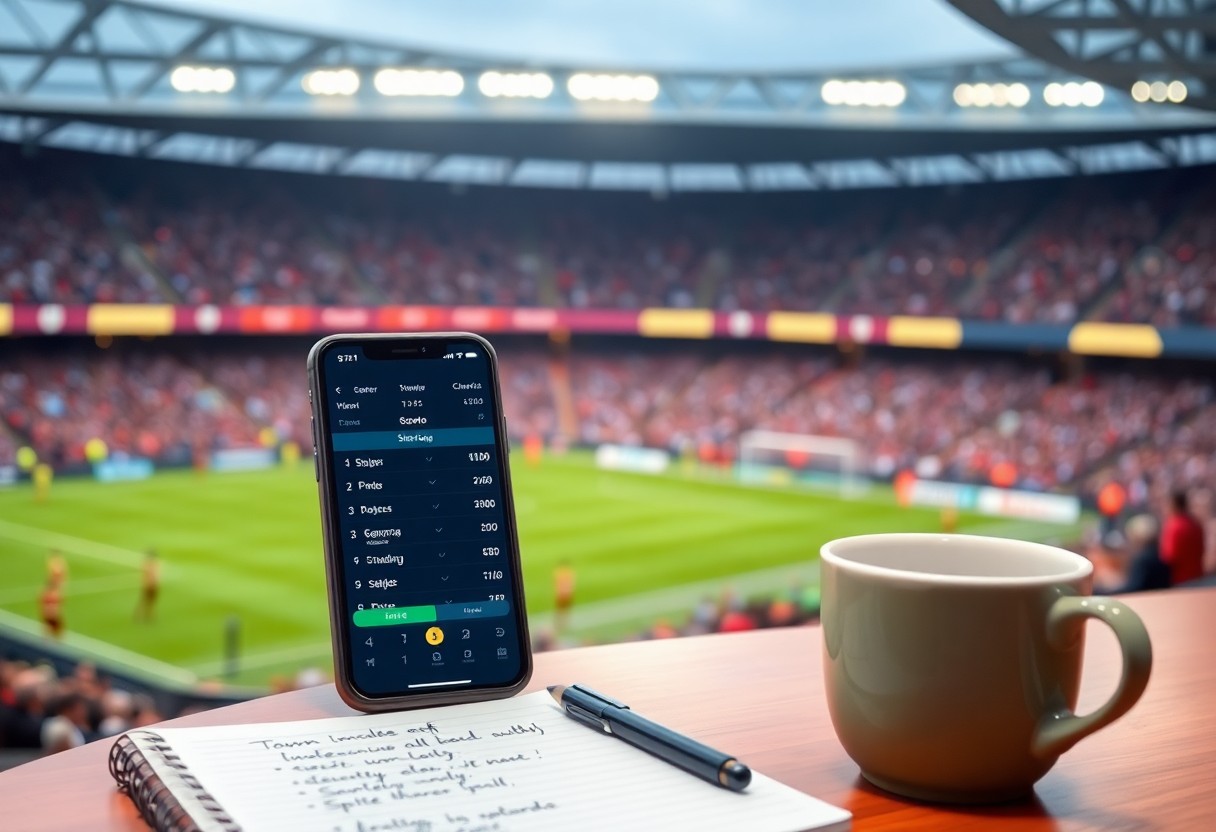Most amateur bettors rely on gut feelings and basic statistics when placing wagers, but professional bettors employ systematic analytical approaches that separate emotion from logic. While you might focus on recent team performance or star player availability, pros dig deeper into advanced metrics, line movement patterns, and market inefficiencies that casual bettors often overlook. Understanding these fundamental differences in approach can dramatically improve your betting success rate and help you avoid the common pitfalls that lead to long-term losses. The gap between amateur and professional analysis isn’t just about knowledge—it’s about disciplined methodology and risk management strategies that treat betting as a calculated investment rather than entertainment.
The Statistical Playbook: Numbers That Matter
Professional bettors operate with laser precision when selecting which statistics to analyze, focusing exclusively on metrics that correlate with actual outcomes rather than impressive-looking numbers. Expected Goals (xG), defensive actions per possession, and shot quality metrics form the backbone of their analysis, while surface-level stats like total shots or possession percentage rarely influence their decisions. You’ll find pros spending hours calculating team-specific conversion rates under different weather conditions or analyzing how a team’s pressing intensity drops after the 70th minute – granular data that directly impacts game flow and scoring probability.
Key Metrics Used by Pro Bettors
Advanced bettors prioritize underlying performance indicators over results-based statistics. Expected Goals difference over the last 10 matches carries more weight than actual goal difference, while metrics like progressive passes, pressures applied in the final third, and conversion rates from specific field positions reveal true team strength. Context-adjusted statistics – such as performance against similar-quality opponents or home/away splits in comparable weather conditions – provide the predictive edge that separates profitable analysis from recreational guesswork.
Misinterpretations Common Among Amateurs
Amateur bettors consistently overvalue flashy statistics while ignoring the context that makes numbers meaningful. Possession percentage, total shots, and recent form streaks dominate casual analysis, despite these metrics showing weak correlation with future performance. You’ll see recreational bettors backing teams with 70% possession rates without considering that many defensive teams intentionally cede possession, or favoring high-scoring offenses without adjusting for the quality of defenses they’ve faced.
The most damaging amateur mistake involves treating all statistics as equally predictive across different contexts. A team’s home scoring average becomes meaningless when they’re playing their first away match in three weeks, yet casual bettors apply these numbers universally. Weather conditions, referee tendencies, and even kickoff times dramatically alter how certain statistics translate to actual performance, but amateur analysis rarely accounts for these variables. Professional bettors understand that a team averaging 2.5 goals per game might struggle to reach 1.5 goals when facing a defensively compact opponent in wet conditions with a referee known for frequent whistles – contextual factors that completely reshape the statistical landscape.
Crafting Situational Context: Beyond the Raw Data
Professional bettors understand that statistics tell only half the story. Context transforms meaningless numbers into predictive insights, separating winning strategies from amateur guesswork. You’ll find that factors like team motivation, scheduling conflicts, and external pressures often override historical performance metrics. Sharp bettors dig deeper into the circumstances surrounding each matchup, recognizing that a team’s 3-0 record might be misleading if those wins came against injured opponents or during favorable weather conditions.
Impact of Game Location and Conditions
Weather conditions and venue characteristics create measurable advantages that amateur bettors consistently undervalue. NFL teams playing in temperatures below 32°F see their scoring decrease by an average of 2.3 points per game, while indoor teams traveling to outdoor venues in winter months cover the spread just 42% of the time. You should factor in altitude changes, surface transitions from grass to turf, and even crowd noise levels measured in decibels when evaluating point spreads.
Historical Performance Analysis
Professional handicappers examine performance patterns across multiple seasons, identifying trends that casual bettors miss entirely. Teams with new coaching staffs perform 15% worse against the spread in their first eight games compared to established systems. You’ll discover that certain franchises consistently struggle in specific situations—like road favorites after bye weeks or underdogs in divisional rematches following blowout losses.
The depth of historical analysis extends beyond simple win-loss records to encompass player-specific matchups and coaching tendencies. Professional bettors maintain databases tracking individual player performance against specific defensive schemes, noting how quarterbacks perform against blitz-heavy teams or how running backs fare on short rest. You should examine coaching decisions in similar game situations, as some coaches consistently make conservative choices in close games while others remain aggressive. This granular approach reveals that a team’s 60% ATS record might drop to 35% when facing opponents who deploy specific defensive formations they’ve historically struggled against.
Mastering the Psychology of Betting: A Mind Game
Professional bettors recognize that psychological warfare extends beyond individual emotions to encompass market dynamics and crowd behavior. You’re not just betting against the bookmaker—you’re positioning yourself against thousands of other bettors whose collective psychology shapes line movements and creates exploitable opportunities. Sharp bettors leverage this understanding by identifying when public sentiment diverges from statistical reality, often finding their most profitable wagers in games where casual money floods one side based on narrative rather than numbers.
Understanding Biases and Market Sentiment
Market sentiment creates predictable patterns that professionals exploit systematically. Recency bias drives public money toward teams coming off impressive performances, while brand bias inflates lines on popular franchises regardless of current form. You’ll notice sharp bettors tracking line movements throughout the week, identifying when professional money contradicts public perception. Books like Pinnacle show reverse line movement in roughly 15-20% of games, where lines move opposite to betting percentages—a clear indicator of sharp action countering recreational sentiment.
- Fade the public strategy works best in primetime games with heavy media coverage
- Contrarian betting becomes most profitable when public backing exceeds 70% on one side
- Line shopping reveals which books cater to sharp versus square action
- Steam moves indicate when syndicates place large, coordinated wagers
Assume that when 80% of bets back one team but the line barely moves, professional money is heavily positioned on the other side.
Emotional Factors That Influence Betting Decisions
Tilt represents the fastest way to destroy a bankroll, yet amateur bettors rarely recognize its early warning signs. Professional bettors implement strict protocols when variance strikes—many stop betting entirely after losing predetermined amounts or making decisions based on frustration rather than analysis. Confirmation bias compounds losses as bettors seek information supporting their existing positions while ignoring contradictory evidence. Studies show that bettors remember wins 40% more vividly than losses, creating false confidence in their abilities and leading to increased stake sizes at precisely the wrong moments.
- Chase betting after losses leads to exponentially larger wagers without improved analysis
- Overconfidence following winning streaks causes stake size inflation and reduced selectivity
- Analysis paralysis prevents action on genuinely profitable opportunities
- Sunk cost fallacy keeps bettors committed to losing positions
Assume that your emotional state directly correlates with decision quality—professionals never bet when angry, desperate, or overexcited.
The most successful professionals treat each bet as an independent event, completely divorced from previous results. They maintain detailed logs not just of wins and losses, but of their mental state during each wager, identifying patterns where emotions influenced their process. Bankroll management serves as their primary emotional regulation tool—by never risking more than 1-3% of their total bankroll on any single bet, they eliminate the financial pressure that creates emotional decision-making. Many pros describe their biggest breakthrough as learning to feel nothing when placing a bet, viewing each wager as a business transaction rather than an emotional investment in an outcome.
- Meditation and mindfulness help maintain emotional equilibrium during variance
- Predetermined stop-loss limits prevent catastrophic losing streaks
- Betting journals reveal emotional patterns that sabotage profitability
- Mechanical betting systems remove human emotion from stake sizing decisions
Assume that the moment you start caring about individual bet outcomes more than your long-term process, you’ve shifted from professional to amateur thinking.
Building Strategic Models: The Systems Approach
Professional bettors construct systematic frameworks that eliminate emotional decision-making and create repeatable processes. Your betting model should incorporate multiple variables weighted according to their predictive power, with injury reports carrying 15-20% influence while recent form accounts for 25-30% of your final assessment. Sharp bettors typically run 3-5 different models simultaneously, comparing outputs to identify discrepancies that reveal either model flaws or exceptional opportunities. The most successful professionals update their systems weekly, adjusting weights based on seasonal performance data and maintaining detailed logs of every prediction versus actual outcome.
Advanced Techniques in Match Prediction
Elite handicappers employ sophisticated analytical methods that go far beyond basic statistics. Expected goals (xG) models provide more accurate team strength assessments than traditional scoring records, while Poisson distribution calculations help determine probable score outcomes. Machine learning algorithms can process thousands of variables simultaneously, identifying patterns invisible to manual analysis.
- Monte Carlo simulations running 10,000+ match iterations
- Regression analysis identifying key performance indicators
- Bayesian inference updating probabilities with new information
- Neural networks recognizing complex pattern relationships
- Ensemble methods combining multiple prediction models
| Traditional Analysis | Advanced Modeling |
|---|---|
| Win/loss records | Expected value calculations |
| Head-to-head history | Contextual performance metrics |
| Basic team statistics | Weighted multi-factor algorithms |
| Gut feeling decisions | Probability-based assessments |
The Role of Simulation in Betting Strategies
Monte Carlo simulations allow you to test thousands of potential match outcomes before placing any wagers. Professional syndicates run 50,000+ simulations per match, generating probability distributions that reveal not just likely winners, but optimal bet sizing and hedge opportunities. Your simulation should account for score variance, timing of goals, and situational momentum shifts that dramatically impact live betting markets.
Simulation modeling extends beyond individual matches to entire betting portfolios, helping you understand risk exposure across multiple positions. Variance testing through 10,000 season simulations reveals your strategy’s long-term expectancy and maximum drawdown periods, enabling proper bankroll allocation. Professional bettors use these simulations to identify correlation risks—when multiple bets might fail simultaneously due to shared variables. Advanced practitioners incorporate real-time data feeds into their simulations, updating probability calculations as lineups are announced, weather conditions change, or market sentiment shifts, giving them significant advantages over static analysis approaches.
Diversifying Bet Types: More Than Just Win/Loss
You’ll find professional bettors spreading their action across multiple bet types rather than limiting themselves to simple moneyline wagers. Smart money flows toward totals, spreads, props, and live betting opportunities where market inefficiencies create value. Your betting portfolio should mirror this approach, with different wager types serving distinct purposes in your overall strategy.
- Totals betting allows you to capitalize on pace and style matchups
- Point spreads provide opportunities when public perception skews lines
- Prop bets offer value in less efficient markets with softer lines
- Live betting enables real-time adjustments based on game flow
- Futures markets reward long-term analysis and early positioning
| Bet Type | Professional Advantage |
|---|---|
| Player Props | Less public attention, softer lines from sportsbooks |
| Team Totals | Isolated analysis without opponent variables |
| Alternative Lines | Customized risk/reward ratios for specific scenarios |
| Derivatives | Correlated parlays and same-game combinations |
| Live Markets | Real-time information advantage over static algorithms |
This diversified approach allows you to attack different market segments while reducing dependence on any single betting style.
Exploring Value Bets and Exotic Wagers
Professional bettors hunt for value opportunities in markets where sportsbooks struggle to set accurate lines. Player props during primetime games often carry inflated juice, while obscure derivatives like “team to score first and win” present softer numbers. Your edge emerges in markets with limited liquidity, where bookmakers rely more on algorithms than sharp money to adjust lines. Exotic wagers such as quarter-by-quarter totals or specific scoring sequences offer the highest potential returns when you’ve identified clear inefficiencies. This approach requires deeper research but provides access to less competitive betting pools.
Risk Management and Bankroll Allocation
Professional bettors allocate different unit sizes based on bet type and confidence level rather than wagering flat amounts across all markets. Your bankroll distribution should reflect the varying risk profiles of different wager types, with conservative sizing on experimental props and larger positions on thoroughly researched core plays. Kelly Criterion calculations help determine optimal bet sizing, typically ranging from 1-5% of your total bankroll per individual wager. This systematic approach prevents emotional decision-making while maximizing long-term growth potential.
Successful bankroll management extends beyond simple percentage allocation to encompass correlation risk and market exposure limits. You shouldn’t concentrate more than 15-20% of your weekly action on a single game or event, regardless of confidence level. Professional bettors track their exposure across different sports, bet types, and time frames to avoid catastrophic losses during cold streaks. Variance management becomes particularly important when dealing with exotic wagers that carry higher standard deviations. Your betting log should include detailed records of unit sizes, bet types, and reasoning to identify profitable patterns and eliminate losing strategies. Drawdown protocols help preserve capital during inevitable losing periods, with many pros reducing unit sizes by 25-50% after losing streaks exceed predetermined thresholds.
Final Words
Hence, the fundamental difference between professional and amateur bettors lies in your approach to data analysis and emotional control. While you might focus on surface-level statistics as an amateur, professionals dig deeper into advanced metrics, injury reports, and situational factors that truly impact outcomes. Your success in sports betting depends on adopting the systematic methodology that pros use: treating each wager as a calculated investment rather than a hopeful guess. By implementing rigorous research standards, maintaining detailed records, and developing the discipline to ignore public sentiment, you can bridge the gap between amateur intuition and professional-level analysis.



